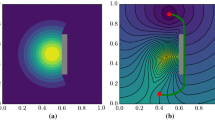Abstract
We consider the surveillance target search problem for the case in which the arrival of targets is modeled by a spatio-temporal Poisson point process and the information measurement system scope is inhomogeneous. A probabilistic description of the inhomogeneity subdomains is given, and patterns of taking them into account when forming the a posteriori intensity density of a random point process are revealed. A search control law synthesis procedure for the case of an inhomogeneous scope is defined. An example is given.



Similar content being viewed by others
REFERENCES
Hellman, O., Vvedenie v teoriyu optimal’nogo poiska (Introduction to the Optimal Search Theory), Moscow: Nauka, 1985.
Ahlswede, R. and Wegener, I., Suchprobleme, Stuttgart: B.G. Teubner, 1979. Translated under the title: Zadachi poiska, Moscow: Mir, 1985.
Abchuk, V.A. and Suzdal’, V.G., Poisk ob”ektov (Search for Targets), Moscow: Sov. Radio, 1977.
Arkin, V.I., A problem of optimum distribution of search effort, Theory Probab. Appl., 1964, vol. 9, no. 1, pp. 159–160.
Boldyrikhin, N.V. and Khutortsev, V.V., Control of observations over random processes fluxes, Autom. Remote Control, 2006, vol. 67, no. 12, pp. 1900–1912.
Baranov, I.V. and Khutortsev, V.V., Current optimization of search of objects for the model of distributed Poisson flow of their appearance, J. Comput. Syst. Sci. Int., 2011, vol. 50, no. 6, pp. 859–869.
Khutortsev, V.V. and Baranov, I.V., Optimal control of surveillance in the problem of discrete search for the Poisson model of the flux of surveillance targets, Radiotekhnika, 2010, no. 3, pp. 20–24.
Khutortsev, V.V., Optimization of sequential-parallel search for objects for the model of the distributed Poisson flow of their appearance, J. Comput. Syst. Sci. Int., 2019, vol. 58, no. 1, pp. 29–39.
Kingman, D., Poisson Processes, Moscow: MTsNMO, 2007.
Last, G., Stochastic analysis for Poisson processes, in Stochastic Analysis for Poisson Point Processes, Peccati, G. and Reitzner, M., Eds., Milan: Springer, 2016, pp. 1–36.
Daley, D.J. and Vere-Jones, D., An Introduction to the Theory of Point Processes, New York: Springer-Verlag, 2013.
Khutortsev, V.V., Intensity density of a space-time Poisson flow with zero probability of occurrence of events on stochastic subsets of its spatial domain of definition, Mat. Mat. Model., 2020, no. 3, pp. 15–28.
Feller, W., An Introduction to Probability Theory and Its Applications, New York: Wiley, 1957. Translated under the title: Vvedenie v teoriyu veroyatnostei i ee prilozheniya, Moscow: Mir, 1964.
Tikhonov, V.I. and Mironov, M.A., Markovskie protsessy (Markov Processes), Moscow: Sov. Radio, 1977.
Author information
Authors and Affiliations
Corresponding author
Additional information
Translated by V. Potapchouck
APPENDIX
Proof of the Theorem. Consider a subdomain of the scope,
By \(A\) we denote the event associated with the arrival of subsequent surveillance targets in \(X_{\mathrm {Ev}} (x) \) from the point process on the time interval \([t,t+\Delta t] \). It is associated with the two conditional probabilities \( P(A/H_{0} )\) and \( P(A/H_{1} ) \). Then we have [13]
Under the assumption of impossibility of the arrival of the next surveillance target in the spatial domains occupied by tracked targets, it is assumed that \(P(A/H_{1})=0 \); then
Let us determine the values of \(P(A)\) and \(P(A/H_{0} ) \),
Taking into account the smallness of \(\left |X_{\mathrm {Ev}} \right |\), we obtain
In view of (A.5) and (A.6), relation (A.4) acquires the form
Let us expand the left- and right-hand sides of (A.8) in a series in a neighborhood of \(t \). Taking into account the condition \(\Delta t\ll 1 \), we will obtain
Divide the left- and right-hand sides of (A.9) by \(\Delta t\) and pass to the limit as \( \Delta t\to 0\). Since \(\lim \limits _{\Delta t\to 0} \frac {o(\Delta t)}{\Delta t} =0\), it follows from (A.9) that
It should be noted that relation (A.10) is similar in its structure to the relation determining the intensity of the Poisson point process obtained under random sparsification [14].
Let us determine the value of \(P_{1}\). To this end, for the components of the vector variable \(\gamma _{k}\), respectively, \(\{ \gamma _{k1}\ldots \gamma _{kn} \} \) \(0<n\le 3 \), we introduce the discretization
The values of \(L_{k} \) and \(\Delta \gamma _{k} \) are taken the same for all \(n \). The Lebesgue measure of the \(n \)-dimensional cube \(\Delta _{\gamma k} \) with sides \(\Delta \gamma _{k} \), defined as \(\left |\Delta _{\gamma k} \right |=(\Delta \gamma _{k} )^{n} \), is substantially less than unity, \(\left |\Delta _{\gamma k} \right |\ll 1 \).
The values of \(L_{k} \) and \(\Delta \gamma _{k} \) are selected so that the domain \(D_{k} \) corresponding to the surveillance target position at the origin falls completely into the \(n\)-dimensional cube with sides \( [-L_{k} \Delta \gamma _{k} ,L_{k} \Delta \gamma _{k}] \).
To the \(k\)th tracked target at time \(t\in \omega _{q} \) we assign the random variables generated by the vectors of indices \(\overline {l}_{D_{k} }^{\thinspace T}=[l_{1D_{k} } \ldots l_{nD_{k} } ]\) such that \(\overline {l}_{D_{k} } \Delta \gamma _{k} \in D_{k} \) and
The condition
We represent the distribution densities of the random variables (A.13) in the form
The probability of \(\varsigma _{k}^{\overline {l}_{k} } (t) \) into \(X_{\mathrm {Ev}} (x) \) at the time \(t \) for some \(\overline {l}_{k} \) is determined by the relation
Set
The events related to random variables from the collection (A.13) corresponding to the \(k \)th tracked target falling into \(X_{\mathrm {Ev}} (x) \) are incompatible. Indeed, two distinct elements of one and the same tracked target from a discrete tuple of elements determined in accordance with (A.13) cannot be simultaneously in one elementary domain of the space \(X_{\mathrm {Ev}} (x) \) by virtue of (A.15). For incompatible events one has the relation
Taking into account (A.15) and passing to the limit in (A.16), we obtain the probability of being at a point \(x\) for some of the elements of the \(k \)th tracked target,
If some element of the \(k\)th tracked target is at the point \(x \), then no element of the other tracked targets may belong to it.
The probability of the event that no element of the \(m \)th tracked target (\(m={1,\ldots ,K}_{q} \), \( m\ne k \)) belongs to \(x \) can be determined in accordance with (A.17),
Consider the event \(B\) that one random variable from the tuples \(\{\varsigma _{k}^{\overline {l}_{k}}(t),\;\overline {l}_{k}\in {\rm M}(\overline {l}_{D_{k}}),\;k={1,\ldots ,K}_{q}\} \) corresponding to all tracked targets falls into an elementary domain of the space \(X_{\mathrm {Ev}} (x) \) at time \(t \). This event may occur in several ways; i.e., it splits into several incompatible versions,
-
–
At time \(t \), \(X_{\mathrm {Ev}} (x) \) captures one of the random variables of the first group \({\{ \varsigma _{1}^{\overline {l}_{1} } (t),\ \overline {l}_{1} \in {\rm M} (\overline {l}_{D_{1} } )\}} \) (event \(B_{1} \)), while the random variables of the other groups \( \left\{ \varsigma_m^{\overline{l}_m}(t),\; \overline{l}_m\in\mathrm{M}(\overline{l}_{D_m}), \mathrm{Im}=\overline{2,K}_{q} \right\} \) do not fall into \(X_{\mathrm {Ev}} (x)\) (events \(\overline {B}_{2},\overline {B}_{3} ,\ldots ,\overline {B}_{K_{q} } \)).
-
–
At time \(t \), \(X_{\mathrm {Ev}} (x) \) captures one of the random variables of the second group \(\{ \varsigma _{2}^{\overline {l}_{2} } (t),\overline {l}_{2}\!\in \!{\rm M}(\overline {l}_{D_{2}})\}\) (event \(B_{2} \)), while the random variables of the other groups \(\{ \varsigma _{m}^{\overline {l}_{m} }(t),\ \overline {l}_{m} \in {\rm M} (\overline {l}_{D_{m} } ),\;m=1,3,\ldots ,K_{q} \} \) do not fall into \(X_{\mathrm {Ev}} \) (events \(\overline {B}_{1},\overline {B}_{3},\ldots ,\overline {B}_{K_{q} } \)); and so on.
Consequently,
Applying theorems on the composition and multiplication of probabilities and using the property of complementary events, we obtain
Taking into account (A.17) and (A.18), for (A.20) we obtain
The assertion in the Theorem follows from (A.12) and (A.21). \(\quad \blacksquare \)
Rights and permissions
About this article
Cite this article
Khutortsev, V.V. Controlled Search for Targets Arriving According to a Spatio-Temporal Poisson Point Process by an Information Measurement System with Inhomogeneous Scope. Autom Remote Control 82, 1568–1580 (2021). https://doi.org/10.1134/S0005117921090058
Received:
Revised:
Accepted:
Published:
Issue Date:
DOI: https://doi.org/10.1134/S0005117921090058



